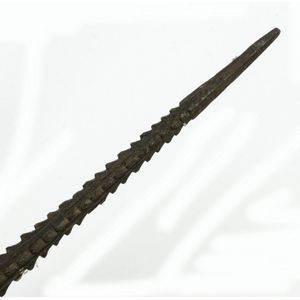Amber Art Deco Cube Necklace
You must be a subscriber, and be logged in to view price and dealer details.
Subscribe Now to view actual auction price for this item
When you subscribe, you have the option of setting the currency in which to display prices to $Au, $US, $NZ or Stg.
- Art Deco Period - The Art Deco period was a cultural movement that emerged in the 1920s and 1930s, and was characterized by its emphasis on modernism, luxury, and elegance. The name "Art Deco" comes from the Exposition Internationale des Arts Décoratifs et Industriels Modernes, a large exhibition held in Paris in 1925 that showcased the latest trends in decorative arts.
Art Deco was a reaction against the ornate and elaborate styles of the previous era, and reflected a new modern sensibility. It was characterized by streamlined, geometric shapes, bright colours, and the use of new materials such as chrome, glass, and Bakelite. Art Deco designers sought to create a sense of luxury and sophistication, often incorporating expensive materials such as ivory, marble, and rare woods.
Art Deco had a significant impact on a wide range of artistic fields, including architecture, fashion, graphic design, and interior design. Some of the most iconic examples of Art Deco architecture include the Empire State Building in New York City, the Hoover Building in London, and the Palais de Chaillot in Paris.
The Art Deco period came to an end in the 1940s, as World War II and changing cultural trends led to a shift in artistic styles. However, Art Deco remains an important influence on design and art, and continues to be celebrated for its modernist sensibility and glamorous aesthetic. - Amber - More frequently used to refer to the colour, than the material from which the word is derived, amber is the fossilized resin from ancient forests. It is not produced from tree sap, but rather from plant resin. The resin is aromatic, and can drip from and ooze down trees. In colour, it may be a deep honey colour, (amber), brown, or white. As it oozes out it fills internal fissures in the tree, trapping debris such as seeds, leaves, feathers and insects. The debris trapped within the amber can assist in dating the deposit.
In its natural state it is found in rocks, on the sea floor (from where it may be washed up to the shore) and mined, using both open cut and underground techniques. About 90% of the world's amber comes from Russia. Amber has recently been discovered at Cape York in Northern Australia
Amber is often incorporated in jewellery, and used in pipe stems. The shine on the surface of amber becomes even more intense when it is worn and used regularly. Genuine amber, when rubbed, will release a slightly musky scent.
This item has been included into following indexes:
Visually similar items

A long old Melanesian fishing spear, with plain circular shaft and tapering 'barbed' tip. Length 277 cm.

A triple strand pearl necklace with Art Deco diamond clip, comprising three rows of cultured pearls of fine lustre and cream/pink colour. Pearls measure 7 mm - 7.5 mm, with Art Deco diamond clip. Lozenge form, comprising three central square cut diamonds s

Two 14ct white gold and diamond cross pendant necklaces One designed as an open work Latin cross framed with brilliant-cut diamonds; the second a stylised Latin cross decorated with brilliant-cut diamonds, both completed by a fine chain. (2)

9ct yellow gold rope twist chain with engraved tassel pendant c.1900. Weight: 8grams
